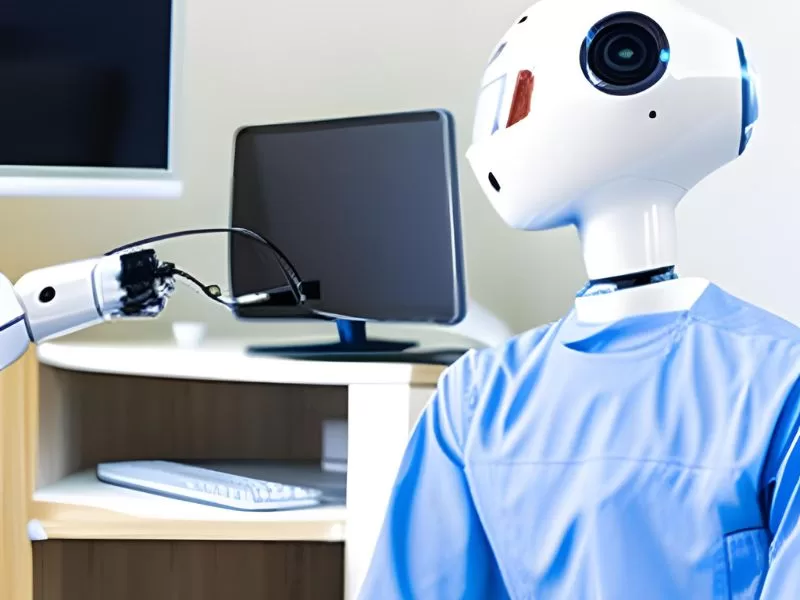The field of healthcare has witnessed remarkable advancements in recent years, and one area that holds immense promise for the future is robotics. Robotics in healthcare refers to the application of robotic technology and automation in medical settings, with the aim of improving patient care, enhancing precision, and increasing efficiency.
As technology continues to evolve, the future of robotics in health care appears bright, offering exciting possibilities for medical professionals and patients alike.

Robotic Assisted Surgery: Robotic in Health Care
Robotic-assisted surgery has revolutionized the field of surgical procedures. Advanced robotic surgical systems, such as the da Vinci Surgical System, provide surgeons with enhanced precision, dexterity, and control.
Generally, these systems consist of robotic arms equipped with surgical instruments that can be controlled by surgeons from a console. The benefits of robotic-assisted surgery include smaller incisions, reduced blood loss, faster recovery times, and improved surgical outcomes. Successful procedures such as prostatectomy, hysterectomy, and cardiac surgery have showcased the potential of robotic-assisted surgery.
However, challenges such as high costs, limited accessibility, and the need for specialized training still exist.
Robotics in Health Care: Rehabilitation and Physical Therapy
Again, Robot-assisted rehabilitation devices have gained prominence in helping patients recover from injuries or disabilities. These devices, such as exoskeletons and robotic prosthetics, assist patients in regaining mobility and strength. They provide targeted therapy, personalized exercise programs, and real-time feedback to monitor progress.
Similarly, the integration of virtual reality further enhances the rehabilitation experience by creating immersive and engaging environments. The future holds even greater potential for advancements in rehabilitation robotics, with the possibility of tailored treatment plans based on individual patient needs.
Telemedicine and Remote Care: Robotics in HealthCare
Telemedicine has emerged as a transformative force in healthcare, allowing patients to receive medical care remotely. Where Robotics plays a crucial role in telemedicine by enabling remote monitoring, diagnostics, and treatment. Again, Medical robots equipped with cameras and sensors can be used to conduct remote physical examinations, collect vital signs, and assist in diagnosis.
On the other hand, telepresence robots enable physicians to interact with patients in real-time, bridging the distance between healthcare providers and individuals in remote areas. The future of telemedicine holds the promise of increased accessibility to quality healthcare services, particularly for underserved populations.
Robotics in HealthCare: Elderly Care and Assisted Living
As the global population continues to age, robotics can play a vital role in providing care and support to the elderly. Robotic companions and caregivers offer assistance with daily tasks, medication reminders, and fall detection.
However, these robots can provide emotional and social support, reducing feelings of isolation and improving overall well-being. Assistive robots equipped with advanced sensors and navigation capabilities can assist in mobility and enable independent living.
Again, the future of elderly care and assisted living holds immense potential for robots to enhance the quality of life for seniors and alleviate the burden on caregivers.
Medical Training and Education: Robotics in Healthcare
Moreover, Medical education and training can greatly benefit from robotics. Simulators and virtual reality platforms enable students and practicing healthcare professionals to gain realistic hands-on experience in a controlled environment.
Surgical training through robotic platforms allows surgeons to refine their skills and improve proficiency. This reduces the learning curve and enhances patient safety during actual surgeries.
By integrating robotics into medical education, the future holds the promise of producing highly skilled healthcare professionals who are better equipped to address complex medical challenges.
Drug Delivery and Pharmacy Automation
In fact, the future of pharmacy and drug delivery is being reshaped by robotics. Robotic dispensing systems in pharmacies automate medication packaging, labeling, and dispensing, reducing errors and improving efficiency.
Likewise, automated medication management systems in hospitals and care facilities help ensure accurate administration of medications, reducing the risk of adverse events. Nanorobots, an emerging area of research, hold the potential for targeted drug delivery, where minute robots can navigate within the body to deliver medications precisely to diseased cells.
These advancements in drug delivery and pharmacy automation can revolutionize patient care, improving medication adherence and overall treatment outcomes.
Data Analytics and Decision Support
On the other hand, the integration of robotics, artificial intelligence (AI), and machine learning has the potential to transform healthcare data analytics and decision-making processes. Robotic systems can collect and analyze vast amounts of patient data, allowing for more accurate diagnoses, treatment plans, and predictive models. AI algorithms can help identify patterns, detect anomalies, and provide decision support to healthcare professionals.
The future of data analytics in healthcare holds the promise of precision medicine, where treatments are tailored to an individual’s unique genetic profile and medical history, leading to improved patient outcomes.
Ethical Considerations and Challenges
While the future of robotics in healthcare presents exciting possibilities, it also raises ethical considerations and challenges. Privacy and security concerns surrounding patient data and remote monitoring need to be addressed. Human-robot interaction and trust are critical factors to ensure patient acceptance and comfort. Ethical implications arise when robots make decisions that affect patient care, requiring clear guidelines and regulations. It is essential to ensure equitable access to robotic healthcare, bridging the gap between technological advancements and the diverse needs of patients.
Conclusion
In brief, the future of robotics in healthcare holds immense promise for transforming the way we receive and deliver medical care. From robotic-assisted surgeries to telemedicine, rehabilitation, elderly care, and medical education, robotics has the potential to revolutionize various aspects of healthcare.
Again, with continued research and development, the integration of robotics, AI, and data analytics will drive advancements in precision medicine, personalized treatment plans, and improved patient outcomes.
As we embrace the future of robotics in healthcare, let us remain optimistic about the positive impact it will have on the lives of patients and medical professionals alike.

